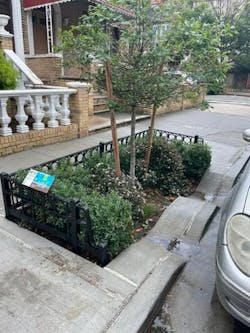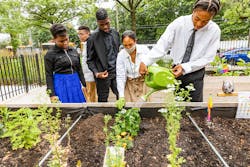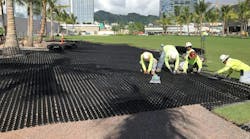With more intense storms and flood events in urban areas, green infrastructure brings essential benefits that continue to rise in value.
Green infrastructure is often defined as a range of design measures that aim to reduce the impact of storm events on existing sewer infrastructure by detaining and treating stormwater locally, helping to divert excess flows away from local waterways, streets, businesses, and homes. These measures can include plant or soil systems, permeable pavement, other permeable surfaces or substrates, stormwater harvest and reuse techniques, or landscaping treatments to store, infiltrate, or transport stormwater.
When many large city stormwater systems were initially developed, the issues we face today did not exist. With major weather events happening more frequently, however, cities are now redesigning the urban environment to better manage stormwater by utilizing green and gray infrastructure approaches to address storm overflows and protect communities from flooding.
Green infrastructure delivers near-term benefits by providing communities better stormwater management, reduced flood risk, improved water quality, and lower levels of pollution. However, there are also long-term benefits to overall community design, as the implementation of a nature-based, green infrastructure theory can create a more resilient population.
This approach is even more important for addressing the needs of traditionally underserved populations in low- to middle-income neighborhoods. Residents in these areas are more likely to experience a lack of safe outdoor spaces, increased congestion and pollution, and a greater likelihood of financial hardships associated with property loss or damage. Attention to environmental justice is paramount in helping improve the quality of life for these populations.
New Orleans Enhances Community, Resilience
In New Orleans, the Blue and Green Corridors project was a re-design leveraging green infrastructure to create better rainfall management and introduce public social spaces to the Gentilly neighborhood where urban flooding is common.
Prior to the project, residents faced frequent damage to property and lacked healthy green spaces. The city sought to utilize the project as an opportunity to transform the neighborhoods impacted while increasing the resilience of the city in a comprehensive manner. This neighborhood redesign process included the use of neutral grounds to capture water while beautifying the community, introducing play spaces for the community, and adding biking and pedestrian pathways.
A model for urban adaptation practices in New Orleans and delta communities around the world, the project provided environmental, social, health, recreational, and economic benefits to the Gentilly neighborhood. Collaborating with design and consulting company Stantec, the work leveraged the EPA Stormwater Management Model (SWMM) to calculate the frequency of storm events and actual reduction of damages, then quantified the improvements with a triple bottom line analysis to capture the effect of flood reductions, healthier lifestyles, and economic activity.
The models showed improvements in all three categories. Plus, an analysis of the data showed the benefits of the improvements would exceed the cost of the project — avoiding $4 billion in potential damages over the next 50 years.
Learning Opportunities in New York
When tasked with creating a more resilient and sustainable solution in New York City, Stantec worked with the Governor’s Office of Storm Recovery (GOSR) and Dormitory Authority of the State of New York (DASNY) to create a plan that would allow communities to better mitigate the impact of climate change and extreme storms while beautifying local neighborhoods.
The project included low- to middle-income areas in Brooklyn and Queens that were at frequent flood risk given the inability to effectively capture enough stormwater — due, in part, to the construction of the neighborhood with high density buildings and paved surfaces, as well as an overtaxed and undersized storm sewer system.
To meet their needs, the design team focused on the concept of designing for community. This approach seeks to always consider what benefits can be added to a community that will go above and beyond functional need, while increasing natural sustainability and health or wellness benefits to those that live there.
The collaboration between Stantec and the GOSR and DASNY teams was critical to the success of the project. The teams helped conduct field research and use available data to identify the most effective locations for improvements. These improvements introduced assets designed to improve the resilience of the city and offer beautifully planted green space that enhances neighborhoods in this project.
Two prominent features in the GOSR/DASNY project were bioswales and rain gardens. The project created over 120 right-of-way bioswales to help capture gutter flow and disperse the water via infiltration, evaporation, and transpiration. These beautifully designed, natural solutions were installed to help capture and divert stormwater to reduce the amount flowing into the city’s overburdened sewer systems. They were also designed to minimize the impact on pedestrians, residents, and businesses in the area while adding dozens of trees that reduce heat, provide shade, and beautify the neighborhoods to provide a positive community feel.
One of the most exciting features of the project is the development of on-site rain gardens at P.S. 993 Catherine & Count Basie Middle School 72 in Rochdale, Queens. The school is located in a dense urban setting and had a very high percentage of impervious surfaces, which made it a perfect fit for improvement.
The paved school lot was transformed into a large multi-use community space complete with rain gardens to capture and infiltrate stormwater, as well as a shade structure designed to capture rainfall and divert it to a rain barrel, providing a sustainable water source for the garden. Working closely with school staff and administrators, Stantec incorporated these green infrastructure practices into a reimagined community garden and outdoor educational space filled with resilient plants.
Thanks to the partnership with GOSR and DASNY, school administration and staff were actively involved throughout the process. From creating a vision through collaboration with the design team at Stantec to completion of construction three years later, the final outcome was nearly identical to the initial plans that reflected the goals of the school.
This close working relationship allowed the leaders of the school to walk away with a learning environment that will provide a long-lasting teaching opportunity. The school can instruct the students they serve in a unique manner that connects with the physical world while solving the very real stormwater reduction issues they faced.
Getting Started
Communities might believe that a green infrastructure project inherently requires a significant investment, with the potential to greatly increase the cost of a stormwater infrastructure or site development project. However, just the opposite is true. Green infrastructure efforts can be very cost-effective and can be implemented on any scale desired based on the needs and available resources of any city or state.
Effective green infrastructure design must consider sustainable changes that can support residents environmentally, socially, and emotionally. From simple, cost-effective designs to larger statewide efforts, design projects of all sizes should be considering green infrastructure as a sustainable, resilient, and efficient stormwater solution. SW
Published in Stormwater magazine, August 2022.








